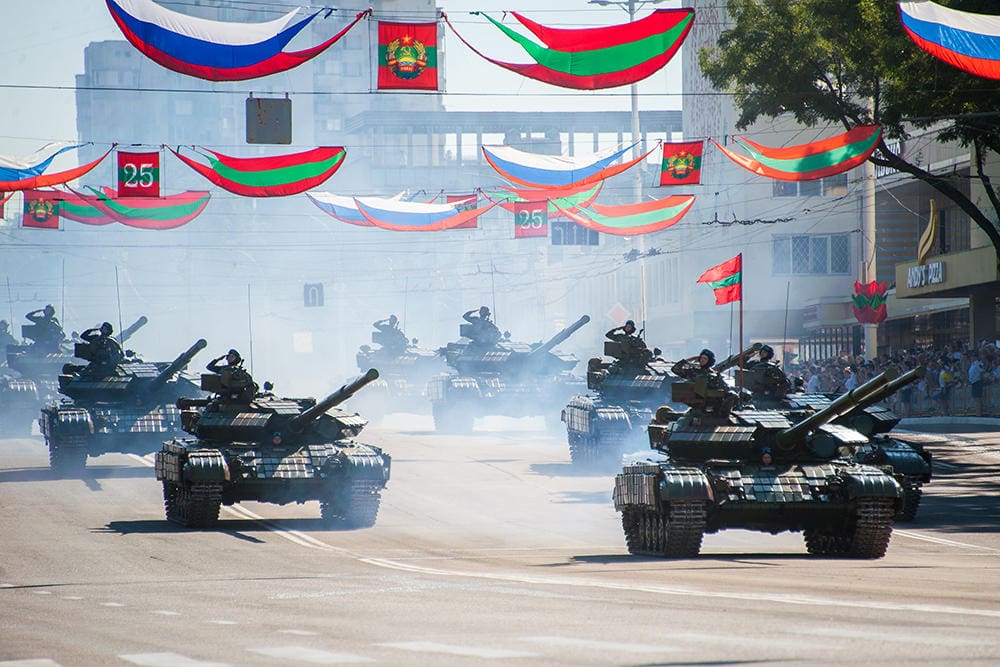Beginning on the 25th of April a series of attacks began in the Moldovan breakaway state of Transnistria. The Transnistrian government is heavily pro-Russian and relies on them for economic aid. The attacks began when three individuals attacked the Transnistrian State Security building with rocket propelled grenades. The building was unoccupied due to it being a day off for Orthodox Easter Monday. In the following days improvised drones attacked a Russian-owned and occupied ammunition depot. Additionally, two radio towers that broadcast Russian programming were destroyed. On the 3rd of May, Transnistrian forces prevented a drone attack and on the 5th of May a drone dropped two explosives near a defunct airfield.
Key Judgement 1: The attacks in Transnistria were highly likely a Russian false flag operation to destabilize the region and create a second front in the Ukrainian conflict.
- Senior General Rustam Minnekayev of the Russian Armed Forces stated that the task of the Russian military is to gain control of Southern Ukraine to establish a land bridge between Transnistria and Crimea. (Source, Source)
- Russia has around 1500 soldiers stationed at the ammunition depot which contains 20,000 tons of ammunition. Since 2015, Russia has had no way to access these troops or ammunition via land routes through Ukraine. (Source, Source)
- The Russian Federal Security Service (FSB) was in Transnistria providing training to the Transnistrian military in the weeks leading up to the attacks. (Source)
- Russia has a history of utilizing false flag operations to advance their political goals. The Soviet precursor to the FSB, known as the KGB, perpetrated false flag operations in Chechnya, Afghanistan, Czechoslovakia, and Finland. Russian president Vladimir Putin also had a long career in the KGB prior to becoming president. (Source, Source, Source)

Key Judgement 2: It is unlikely that the attacks in Transnistria were perpetrated by any official element of the Ukrainian military.
- Ukrainian forces are currently pushing back the Russian advance in southern Ukraine. It is unlikely that Ukrainian forces are capable of diverting time and resources to provoke Transnistria. Additionally, a provocation of Transnistria offers no tactical or strategic advantage to the Ukrainians, rather it would place them in the middle of a pincer manoeuvre. (Source)
- The timing and execution of the attacks indicate there was very little planning behind them or the intent was to do as little damage as possible. However, Ukrainian Special Operations Forces have proven to be exceptionally capable saboteurs. The perpetrators attacked the Transnistrian State Security building on Orthodox Easter Monday, a day when no one was inside the building. Ukrainian instigators would have known that the building was likely to be unoccupied on this day. The radio transmitters broadcast Russian radio programs. The attacks resulted in zero casualties and no significant damage to infrastructure. The attacks give the appearance that Russia is using Transnistria to undermine international support for Ukraine, while trying to do as little damage to their ally as possible. (Source, Source)
- On the 3rd of May Russian state media released images of a drone downed in another attempted attack. The drone was reportedly homemade and capable of carrying a 20kg payload over 30Km. There is a realistic probability that the drone is a disinformation attempt. The drone is held together with duct tape and sustained minor damage given the circumstances in which it was recovered. (Source)

Key Judgement 3: It is highly unlikely that these attacks will have any significant immediate impact on the conflict in Ukraine, if at all.
- Currently, Ukrainian forces are pushing back the Russian advance in the south. It is highly unlikely that the Russians will be able to establish the land bridge they initially sought (Source).
- Despite the president of Transnistria claiming the attacks were perpetrated by Ukraine, he has stated that Transnistria will not be pulled into the conflict. (Source)
- In the days following the attacks, NATO’s Deputy Secretary General Geoana stated that he is expecting false flags to occur, and that Moldova is in danger of being attacked. (Source)
Summary
The attacks in Transnistria are highly likely to have Russian origins with the intent of doing as little damage to their regional ally as possible. There is no evidence that the attacks have Ukrainian origin. Russia has far more to gain from pulling Transnistria into the conflict than Ukraine. However, the attacks will likely have no effect on the larger conflict since Russia can’t physically get their forces there.
Intelligence Cut-Off Date: 7th May 2022

